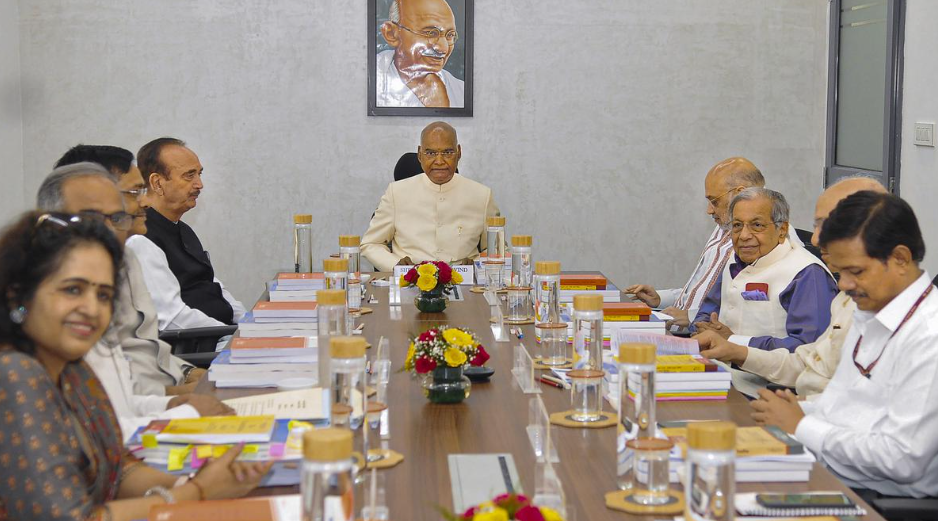Roadmap for One Nation, One Election in India (GS Paper 2, Polity)

Why in News?
- The Union Cabinet has recently approved a proposal for the "One Nation, One Election" initiative, aiming to synchronize elections for the Lok Sabha (the lower house of Parliament), state Assemblies, and local government bodies.
- This proposal follows the recommendations of a High-Level Committee led by former President Ram Nath Kovind and represents a significant shift in India's electoral framework.
History of Elections in India
Era of Simultaneous Elections
- Initial Implementation (1951): The first general elections in independent India were held simultaneously for the Lok Sabha and state Legislative Assemblies. This approach aimed to create a cohesive electoral cycle.
- Subsequent Elections: The practice of holding concurrent elections continued for the next three cycles, with a few exceptions where mid-term elections were necessary due to political instability. Notable instances include:
- Kerala (1960): Early dissolution led to a separate election.
- Nagaland and Puducherry (1962): Assemblies were formed after the general elections, affecting simultaneous polling.
- Last Near-Simultaneous Elections (1967): The last instance of nearly simultaneous elections was in 1967, after which political developments led to the fragmentation of this cycle.
Beginning of the End
- Premature Dissolutions: The premature dissolution of the Lok Sabha in 1971, followed by extensions during the National Emergency (1975) and subsequent dissolutions after the 1977 elections, began to erode the regularity of simultaneous elections.
- Current Status: Over the past two decades, only a handful of state Assemblies have held elections alongside the Lok Sabha elections, resulting in multiple rounds of Assembly elections annually. This fragmented approach has led to political fatigue among voters and increased electoral costs.
Roadmap for Simultaneous Polls
Steps Needed After Union Cabinet Approval
- Constitutional Amendments: Implementing the One Nation, One Election initiative requires two Constitutional Amendment Bills to be passed by Parliament. The complexity of these amendments necessitates careful planning and consensus-building.
- Building Consensus: The government may refer the proposed bills to a parliamentary committee that includes opposition members to foster dialogue and agreement across party lines. This step is crucial for ensuring a smooth legislative process.
- State Ratification: For local body elections to be synchronized with national and state elections, at least half of the states must ratify the Constitutional amendments. This process involves considerable negotiation and coordination with state governments.
Changes Needed in the Constitution
First Amendment Bill
- Special Majority Requirement: This bill will need to pass with a 'special majority' in both houses of Parliament, which entails:
- Approval from at least half of the total membership of both the Lok Sabha and Rajya Sabha.
- A two-thirds majority of the members present and voting in favor of the amendment.
Second Amendment Bill
- Alignment of Local Body Elections: This bill aims to bring local body elections in line with simultaneous elections and requires:
- Ratification by at least half of the state legislatures, as local governance falls under the State List in the Constitution.
Potential Outcomes if Bills are Passed
- Implementation Mechanism: If both bills are successfully passed, the President will issue a notification during the first Lok Sabha sitting after a general election. This notification will activate a new Article 82A in the Constitution, marking the start of the simultaneous elections process.
- Dissolution of State Assemblies: State Assemblies elected after the "appointed date" will dissolve at the end of the Lok Sabha's term. Some Assemblies may need to dissolve early to synchronize their elections with the Lok Sabha elections.
- Mid-Term Elections: In cases where an Assembly or the Lok Sabha is dissolved prematurely, mid-term elections will be conducted. The newly elected body will serve only until the next scheduled simultaneous elections, referred to as the "unexpired term."
- Role of the Election Commission: The Election Commission of India (ECI) will play a pivotal role in managing this transition. If the ECI determines that simultaneous elections for a particular state Assembly are not feasible, it can recommend a delay while ensuring that future elections are still conducted concurrently.
- Unified Electoral Roll: The ECI will also be responsible for creating a unified electoral roll that encompasses all elections—Lok Sabha, state Assemblies, and local bodies. This roll will be developed in collaboration with State Election Commissions to streamline the electoral process.
Conclusion
- The One Nation, One Election initiative represents a transformative step in India's electoral system, aiming to streamline elections and reduce the frequency of electoral exercises.
- While the proposal has the potential to enhance administrative efficiency and minimize electoral costs, its successful implementation will require extensive dialogue, consensus-building among political parties, and careful constitutional amendments.
- By aligning elections across different levels of government, the initiative seeks to foster greater political stability and improve governance in India.
- However, the complexities involved, particularly in obtaining state ratifications and navigating opposition concerns, present significant challenges that must be addressed for this vision to materialize.


